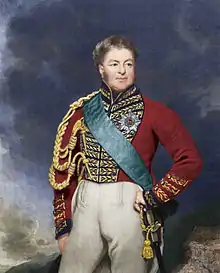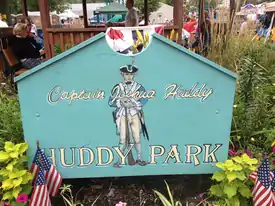Joshua Huddy
Joshua "Jack" Huddy (November 8, 1735 – April 12, 1782), the commander of a New Jersey Patriot militia unit and a privateer ship during the American Revolutionary War, was noted as a figure of controversy after he was executed by irregular forces of the Associated Loyalists. He had been twice captured by Loyalist forces, escaping after the first time.
_(14782586454).jpg.webp)
His execution was noted for precipitating one of the first international incidents of the fledgling United States. To retaliate for Huddy's execution, the Continentals wanted to execute a young captive British officer, which would have violated the terms of the Yorktown surrender and was known as the "Asgill Affair".[1] The French government, allies of the US, put pressure on the Americans to show the officer mercy, and the Continental Congress voted to order his release, as Washington had turned the issue over to them.
Early life
Huddy was born November 8, 1735, to a prosperous family in Salem County, Province of New Jersey, the oldest of seven brothers. His grandfather, Hugh Huddy, was a well-known judge in Burlington. Huddy spent most of his early life in Salem, where he was considered rebellious and a troublemaker. He was disowned by Quakers in Salem in 1757 for his "disorderly" conduct.
His "rough ways" continued into adulthood; he was tried and convicted several times for crimes including assault and theft and repeatedly had financial difficulties. He was forced to sell a 300-acre (1.2 km²) plantation in Salem to pay his debts and was forced into debtor's prison for a time. In 1764, he married his first wife, the widowed Mary Borden, by whom he had two daughters, Elizabeth and Martha, before her death.
In the 1770s, Huddy moved to Colts Neck in Monmouth County. There, on October 27, 1778, he married his second wife, Catherine (Applegate) Hart, also a widow and owner of the Colts Neck Tavern, which she had inherited from her first husband, Levy Hart. Huddy was later accused by the Monmouth County sheriff of trying to steal the tavern from his wife and to force her children out onto the street. He often appeared in civil and criminal court, either as plaintiff or defendant.
Military career
Huddy allied with the American revolutionists and engaged in the raids and revenge executions that characterized the intense violence among Monmouth County residents, often involving personal feuds. The actions continued even after the war. He served as captain of the Monmouth Militia from March to December 1779. Huddy led several raids in which he and his men seized materials allegedly sold illegally to the British in New York; he captured and sometimes executed Loyalists. He was accused of hanging Stephen Edwards, the first Loyalist to die in the county, and 14 others. He denied at least one of the murders.
In August 1780, Huddy was issued a commission to operate a gunboat, The Black Snake, as a privateer. One month later, he was captured in his house in Colts Neck at night by 25 Loyalist raiders led by Colonel Tye, a former slave. Huddy and his mistress Lucretia Edmonds held off the attackers in a two-hour-long gun battle, but after the Loyalists set fire to his house, Huddy agreed to surrender to if they would extinguish the blaze.[2] Colonel Tye marched Huddy to what is now West Park in Rumson, New Jersey, where he was put on a boat to go to New York, which was occupied by the British. However, Patriots on the other side of the Shrewsbury River fired on the boat, which capsized. Huddy, wounded in the thigh, managed to swim to shore and escape.
Capture and execution
On February 1, 1782, Huddy was given command of the blockhouse, a small fort, at the village of Toms River that was built to protect the local salt works. The salt was needed to cure meat destined for American troops, and the Toms River was an important launch point for Patriot privateers. On March 24, a large irregular force of the Associated Loyalists, an organization headed by William Franklin, overwhelmed Huddy's small band of defenders and took the fort. They destroyed the blockhouse, salt works, local mills, and all but two houses in the village, leaving dozens of people homeless.[3]
As an officer, Huddy was transferred to a military prison ship at New York, then held by the British.[4] Soon, however, Huddy was removed from British custody by a band of Associated Loyalists, headed by Captain Richard Lippincott, ostensibly for the purpose of making a prisoner exchange.[4] No such exchange was planned, however. Instead, Lippincott's forces took Huddy by boat to Middletown Point, a location on the south coast of Sandy Hook Bay. They landed on the beach at the foot of the Navesink Hills. There, on April 12, 1782, they hanged Huddy after they had allowed him to dictate and sign his will.[3]
In the rounds of retaliation, Huddy's summary execution by the Loyalists was retaliation for the death in Patriot custody of Loyalist farmer Philip White. The Loyalist executioners left a note on Huddy's breast: "Up Goes Huddy for Phillip White." It was reported in a letter to Washington that Huddy died calmly and bravely, declaring that he would "Dye [sic] Innocent, and in a good Cause."[5]
The next morning, Patriots found Huddy's body hanging from the gallows, cut it down, and brought it to Freehold, where they buried him at Old Tennent Church.[6] More than 400 people gathered to protest his execution, and a petition was sent to General George Washington to demand retribution by execution of a British officer of similar rank if Captain Lippincott was not surrendered.[3] Both Washington and the commander of British forces in New York, General Sir Henry Clinton, condemned the hanging. The British forbade the Board of Loyalists from removing any additional prisoners. Sir Guy Carleton, Clinton's successor, later abolished the organization.
"Asgill Affair"

Patriotic sentiment ran high following the killing of Huddy. In an effort to avert independent reprisals by the New Jersey militia, Washington agreed to the proposition to select a British prisoner of war for retaliatory execution.[4] Washington issued an order to General Moses Hazen to select a British prisoner by lot to be hanged in retribution.[4] Straws were drawn on May 26, 1782 and a young British officer, Captain Charles Asgill, drew the short straw. If Lippincott was not turned over to the Patriots for trial, Asgill was to be killed.
The situation was complicated by the fact that Asgill and the other British captive officers were protected under the terms of surrender agreed to between British General Charles Cornwallis and Washington following the Siege of Yorktown in October of the previous year.[4] Executing Asgill would have violated the terms of the surrender and created a black eye for the rebellious colonials who were intent upon establishing an independent nation.[4]
Washington turned to an old associate, General Benjamin Lincoln, formerly the second in command of the Continental Army and the acting Secretary of War of the Americans.[4] While he and other ranking Continental Army officers continued to favor a retaliatory killing, they urged patience.[4] The delay ultimately allowed sufficient time for intercession by the Americans' French allies. The mother of the condemned British captain appealed directly for help to French King Louis XVI and his wife, Marie Antoinette. French Foreign Minister Comte de Vergennes was directed to plead Asgill's case to Washington.
Catherine Hart, Huddy's widow, also said that she wanted Asgill's life spared since the captain was innocent.
Backed by diplomatic pressure to lift the execution order, the military turned the issue over to the Continental Congress for decision. Asgill was freed by order of Congress passed on November 7, 1782.[4] Asgill was issued a pass to British lines and returned to Britain. After the war, Lippincott emigrated to Canada, where the Loyalist was granted 3,000 acres (12 km²) by the Crown as a reward for his services to Britain.
Legacy

Huddy's legacy lives on throughout Central New Jersey, specifically Monmouth County. In Highlands, New Jersey, Huddy Park as well as a street are named after him. A plaque in West Park in Rumson, New Jersey honors Huddy's escape from the capsized boat he was captured on.[7] Another plaque in Colts Neck, New Jersey was erected in 1977.[8] There is also a Huddy Park in Toms River, New Jersey.
See also
References
- "A Melancholy Case". Retrieved 21 August 2019.
- Daniel Mark Epstein. Loyal Son. pp. 330–331.
- Virginia Watson Reeve, "The Story of Captain Joshua Huddy," Joshua Huddy Chapter, National Society Daughters of the American Revolution, Ocean County, NJ, March 30, 1950.
- Benjamin Johnson, "General Washington's Terrible Dilemma," Massachusetts Historical Society, October 2007, www.masshist.org/
- "From George Washington to John Hanson, 20 April 1782". Rotunda. Retrieved 21 August 2019.
- "CAPTAIN HUDDY'S STORY". ancestry.com. The National Society of the Daughters of the American Revolution. Retrieved 31 August 2014.
- "JOSHUA HUDDY: THE SCOURGE OF NEW JERSEY LOYALISTS". Journal of the American Revolution. Retrieved 7 March 2020.
- "Capt. Joshua Huddy Historical Marker". Historical Marker Database. Retrieved 7 March 2020.
External links
- "Revolutionary War Sites in Toms River, New Jersey: Joshua Huddy Park," Revolutionary War New Jersey, www.revolutionarywarnewjersey.com/
